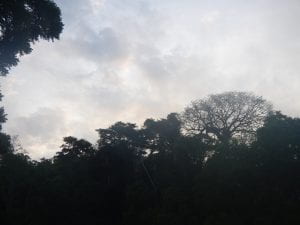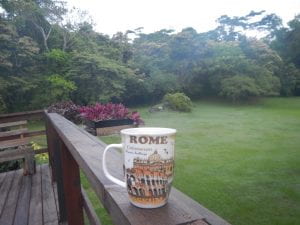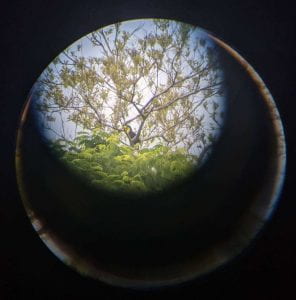This morning, we went out to collect our camera traps in the rainforest. We also learned about ant lion caterpillars and saw their homes underneath the lodging of the research station.
This afternoon, we went through double the usual amount of presentations, since tomorrow will be our travel day. Overall, we learned about Fungi & Lichen, rainforest mammals, diseases and parasites, hard corals, sponges, and coral reef frameworks. I will include a little about what I learned from each of them.
For fungi and lichen, I learned about some cool different species. Turkey tail fungi are concave, fan-like, brown-grey in color, and grow in shelf-like clusters. The common tree oyster is concave, fan-like, solid, white-grey/brown, and also grows in shelf-like clusters. Common puffballs are convex, pear-like, solid white, have internal reproductive structures, grow individually, and are attached to decaying wood. The common green-shield lichen are foliose, have round lobes, grow loose to bark, and are light-green to yellow in their coloration. The common southern soldiers lichen have red reproductive structures, are generalists, and are usually green to grey in color. The asterisk lichen are small, tight and crowded in their growth patterns, and are often star-shaped. I also learned that lichen can grow on nearly anything, even a glass bottle!
On rainforest mammals, I learned that they all have lightweight bones and flexible joints. Some of the most interesting species discussed included the jaguar, margay, procionidae, and coatimundi. The jaguar is South America’s largest cat and is the apex predator of the jungle. It is very muscular, has a distinctive pattern on its fur, and apparently there are around 400 that live in the Chiquibul rainforest. The margay are small, noctournal cats with a distinctly rounded head, large eyes, and a very long tail that climb head-first down trees. The procionidae family includes racoons and they are distinctive for their elongated bodies and shortened legs. The coatimundi is diurnal, have long, pointed snouts, and tails that are nearly half of their body length. Mammals are essential for seed dispersal and pollination in the rainforest. Also, bats are the only winged mammals in the rainforest. It was really cool to learn about all of these mammals, so far the only ones I have seen are goutti in the garden and bats in the rafters.
The diseases and parasites lecture was really fascinating and it made me very glad that I had my Malaria meds with me. Apparently malaria has been in decline and dengue fever has been on the rise based on recent studies. Yet, we also learned that malaria cases are widely under-reported, and many more people get the disease than most numbers suggest. There were several other diseases highlighted in the lecture, but the main takeaway for me was to wear bugspray consistently and light layers whenever I’m in the rainforest.
The hard corals presentation was a fun change of pace since it was the first reef lecture we’ve had to far! Corals are the backbone of the reef ecosystem and are comprised of groups of polyps. They have tentacles and are often engaged in symbiotic relationships with algae species. Also, they are all capable of stinging!! I already knew that some coral were venomous, but I had no idea that they were all dangerous, which is important to know before getting there.
Sponges are quite simple organisms but it was cool to learn a bit more about them. As an organism, sponges’ living strategy is working as a conglomerate of cells together, each cell processing oxygen and CO2 and discharging waste into the sea. They can reproduce sexually or asexually, with there being some tradeoffs for each method. For sexual reproduction, sponges will bud, which results in no genetic diversity, and they cannot get very far, but it is safer and more reliable than sexual reproduction. Sponges may participate in sexual reproduction if their own environment is in danger and they need their offspring to go further.
The final presentation on coral reef frameworks taught me a lot about the overall diversity of the coral reef. There are a lot of destructive forces that can harm reefs, and they are an extremely delicate ecosystem.
Looking through our camera trap photos this evening did not disappoint at all! My camera honestly captured
one of the best photos with a puma strolling down the path!
Tonight, we had a little campfire in the rainforest and had a great time reflecting on our highs and lows of the trip so far. I said that catching the puma on my camera was definitely a high, and that findings all of those cockroaches in my bed on night 3 was a low. It was lovely to just stop for a moment and reflect with everyone on how special this trip has been.

Tomorrow we will depart and make our way to the ATM caves! So I’m (hopefully) off for an early bedtime.
-Emily




